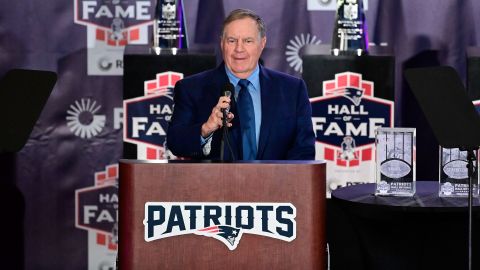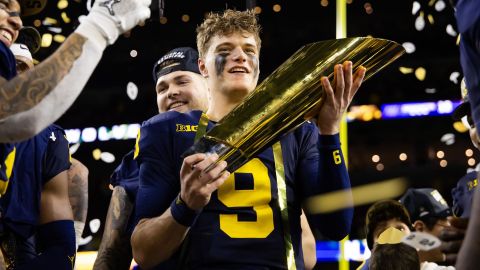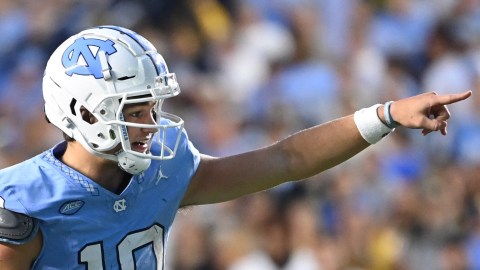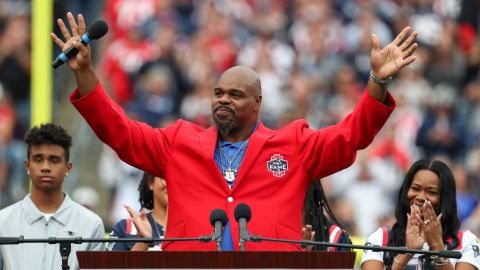 The voices of reason had it wrong this time.
The voices of reason had it wrong this time.
As NBC’s promos for Sunday Night Football rolled, billing the Week 12 matchup between the Patriots and Broncos as Manning Brady XIV, the common refrain was heard again: Sure, Tom Brady and Peyton Manning’s teams are playing each other, but this is not Brady-Manning. Neither player really controls the other’s outcome, and it’s not like they’re going at each other for supremacy like Larry Bird and Magic Johnson.
Usually, the refrain is right. Saying Brady has a better record than Manning when they play each other is saying nothing about Brady or Manning, unless it’s also saying something about each team’s respective defenses, collaborators on offense or coaching staffs (Manning-Belichick may be more accurate, if not better marketing). Judging the two by their head-to-head results and stats is almost like judging the two by the clichéd story arc that Manning may have the better career stats, but Brady can win the big ones — curves that have been evened out by time and fact, with what’s remaining just knowledge that they’re both very good, and they’ve both been blessed to play for great organizations.
This Sunday night, though, it was Brady-Manning. And Brady won.
Never before in a Brady-Manning matchup has the outcome so heavily depended on how the individuals performed and who was really the better quarterback, and never before has more actual evidence been produced that Brady just has something in these games that Manning doesn’t.
Again, in the grand scheme, caveats have to be given for defenses and supporting casts. Both quarterbacks had certain capable receivers to throw to, and both had defenses that were on the field when they were not, confounding their opponent. But in this game more than any other previous Brady-Manning showdowns, the playing field was remarkably even, and the wiggle room for the quarterbacks to let someone else do the job was smaller than ever.
Both quarterbacks were pressed into situations where they had to produce for their teams to win, and Brady made it happen, while Manning did not.
It started with the Broncos’ big 24-0 first-half lead. While Denver was dominant, the funhouse half was the rare situation where the success was not because of Manning. Thanks to the Patriots fumbling the ball almost as soon as they got their fingers on it in their three opening possessions, the Broncos ended up with a defensive score and short fields on the way to a 17-0 lead. Manning didn’t need to do anything, and he didn’t — but that “didn’t” soon became more noticeable when Denver was pressed to put together drives of its own and couldn’t.
The Broncos had three more possessions before the half, and they scored on one while punting on the two others. In those drives, running back Knowshon Moreno was the one who made it happen. He chewed up yards on the ground, totaling 62 yards, while Manning threw just 10 passes, completing six of them for 53 yards (37 of those yards came on short dumps to running backs, including Moreno). Manning didn’t look bad in the first half, and the offense was certainly respectable, but the fact that Manning never exploded for the type of chain-moving offense he’s best known for turned out to be a harbinger for the rest of the game.
After halftime, the Broncos struggled on offense. They punted twice and turned the ball over twice (one a Manning interception), and they didn’t get close to scoring until Manning finally put together the drive that ended with the tying touchdown with 3:10 left. That drive was vintage Manning. But Manning’s mere 132 yards through the air on the night, his 52.7 completion percentage, his 3.5 yards per pass and the Broncos leaning heavily on the run throughout (280 total rushing yards) was the more complete story. Manning had one drive to hang his hat on against the Patriots. For the rest of the contest, he was taken out of the game.
That’s where the discussion circles back to Bill Belichick, and remembering that Manning was competing against a defense designed to keep his game from beating the Patriots (thus opening the door to the run). But Manning had 36 throws, countless play calls and many moments where one pass could change the game. In those situations, he just didn’t play at a high level. When the game got tight and the result depended on which quarterback could march his team down the field, Manning had his underwhelming second half — and the overtime period, where the Broncos came up short twice (although Brady’s aura was fading by then, too). Manning, who regularly has his way with defenses, did not produce when pushed to a higher challenge.
Brady, meanwhile, played like a dog racing for freedom after finally wriggling out the back door. New England’s first half was atrocious. Even putting the turnovers aside, the Patriots just couldn’t get their units to play together for any stretch. The offense was far from being in rhythm, and it seemed like the team was just holding its breath through turnovers and defense-gashing runs until it could get to halftime. Brady barely had time to set up the offense or throw, and when he did, the Patriots could do nothing with it.
In the second half, though, Brady was an example of execution and capitalizing on opportunities. He forged his 34-for-50, 344-yard, three-touchdown night on the back of New England’s 31 unanswered points. Brady was a tactician at the line, calling the plays and rushes, but he was also as precise with his throws as he’s ever been. With touch passes and bullets, he led five straight efficient scoring possessions to get the Patriots not only back in it but also dominating, with the defense following suit.
The Patriots got similar help in the second half off turnovers as the Broncos did in the first. But Brady was ruthless in finishing off those opportunities. He pushed the up-tempo offense, which must have an excellent completion rate to keep rolling. The Brady who has peeked up in the last two weeks — in stark contrast to the inconsistent Brady who has struggled to make throws and keep the Patriots moving on third down — was at it again Sunday night, with less clock time and a smaller margin for error pushing him to be better and faster.
On the first drive out of halftime, Brady threw seven times on the eight plays and completed every one of his passes. That drive got the Patriots on the board. On the next sequence, off the Denver turnover, the Patriots used mostly running plays, but on the next two possessions, Brady again was throwing. The first of those possessions included just five plays overall, four of them passes, with Julian Edelman’s deep completion doing most of the work before Rob Gronkowski’s touchdown. On the next possession, off Manning’s interception, Brady carved up another short field, and by the time he led the Patriots to a field goal on the possession after that, he had engineered 31 unanswered points while throwing just five incompletions.
What was most incredible about Brady’s night, though, were the conditions he was playing through. With the wind causing problems all night — and even prompting Belichick to hand Manning the ball in what could have been a sudden-death loss — Brady didn’t wait for the weather to subside when he got his chance in the second half. Brady was masterful at navigating the gusts and completing his passes, and his ability to make throws into the wind while Manning could not was the ultimate decider.
The biggest feather in Brady’s cap from Sunday night, however, circles back to the debate that many have said should not be a debate at all. Why is it called Manning-Brady? Why are those two pitted against each other, especially when they do nothing to influence what the other does on the field? (Why were viewers besieged by graphics about them in the first half, when the star of the show was the art of fumbling?)
At other points, and in other games, it may have been correct to say that Brady and Manning’s worth cannot be measured by how they perform when their counterpart is their opponent. But this Sunday night, it was different. The teams were evenly matched, and the way to win for each team was to keep the opposing quarterback from having free reign. Belichick crafted a scheme meant to limit Manning. The Broncos deployed a game plan focused on stopping Brady. Both teams, with their capable defenses, gave both quarterbacks a referendum to prove their ability, with the stakes getting higher with each turn of the resolve-testing game.
Both quarterbacks were thrown into the game of the ages, with both facing scenarios meant to push them to their best. Both left a record of how they play when tested most. They just happened to be playing each other.
Brady got it done, and he had the big stats, too. Manning did not. Not every contest between the two has been such, but Sunday was: Brady-Manning was a real thing, with legitimate implications, with Brady overcoming his odds while Manning struggled against his — at least for one night.



